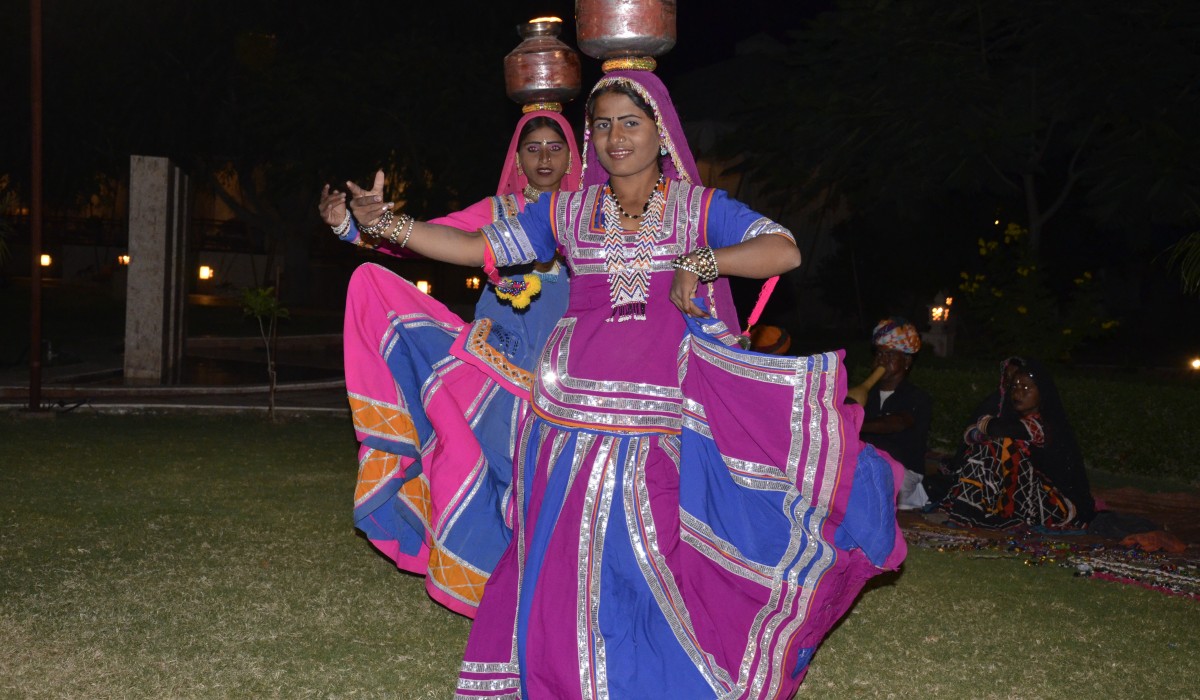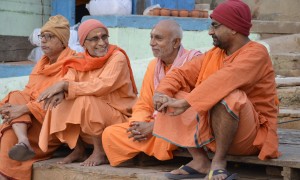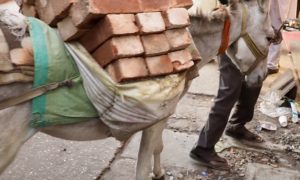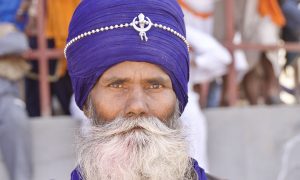The turbans and saris in India totally captivated me.
We traveled in the Northern part of India for two weeks in November and while I loved the palaces, forts and exotic nature of this part of the world, the way the women and men dressed was absolutely mesmerizing.
My back ground as a fashion writer probably has something to do with why the colorful attire grabbed my eye…but maybe you’ll find them equally interesting.
Interestingly there is no wife at home, advising, “Dear, I think you should wear your navy turban today,” the way we western women might advise our husbands about which tie to don before going out.
Instead the turban–typically a strip of cloth five meters or less– is prescribed. It is a man’s “identity.”
In many instances, it has a religious significance but the color of a turban can indicate a man’s profession or his caste. For example, shepherds are pink, farmers are another color. I often wondered when I saw a brightly patterned turban—what does that mean?
According to Wikipedia, the color can be selected for the occasion as well. White is associated with peace and worn by elders. Pink, often assoicated with spring, is worn during that season or for marriage ceremonies. I noticed snake charmers in different places all had the same kind of turban. Hmmmm.
The turban is also an important tool in every day life. It can provide an extra layer of warmth around the shoulders, act as a pillow and hide small valuables in its folds. I saw a man take off his turban and use it to pull a man in a wheel chair up a ramp at a train station.
It was amusing to me to see the impact of every day modern life in India. At stop lights I observed men on motorcycles, wearing their helmets with the turban wrapped under one arm and over the other shoulder, kinda like a beauty pageant woman wears a sash to indicate her allegiances. My assumption is that when the man arrives at his destination, he takes off the helmet and spends a few minutes rewrapping his turban to resume his daily life.
The saris that the women wear are equally interesting–making them radiant from head to toe. We saw women in the fields, walking on country roads, in the towns–all dressed in their beautiful, colorful draped scarves.
A sari is a strip of unstitched cloth four to nine yards in length that is draped over the body in various styles. It is typically worn over a long skirt of the same color and a tight fitting blouse called a choli.
They indicate where a woman is from both in color, pattern and the way they are tied. I love this. Combined with boatloads of jewelry and the Bindi–a traditional mark between the eyes, the effect is stunning.
I even liked seeing them draped on bushes or out windows to dry on laundry day. The splashes of color are fabulous.

























Comments
11 CommentsPeggydepersia
Jan 24, 2012So exotic…..what could we describe as exotic in America these days?????
Susan
Jan 31, 2012Good question.
Margnault
Jan 31, 2012Amazing photos! Love this blog. Thank you!
Susan
Jan 31, 2012Thanks, Margaret. It was an amazing experience to see the gorgeous colors and elegant attire in the most rural of settings as well as in the cities.
India: Country of Colors | DesignDestinations
Feb 18, 2012[…] with the women wrapped in their silky sari’s. The flowers. The rangoli’s. The bright turbans telling so much about the […]
| DesignDestinations
Jun 4, 2013[…] At night it was a sleeping bag and it could be used for many other things. This made me think of the Turbans I saw in India and how they were often used for other purposes than a head wrap. Click here for a link about turbans. […]
Bhutan: land of colorful clothing | DesignDestinations
May 25, 2015[…] It’s called a Kabney—typically made of raw silk. The color determines the rank of the individual. Regular citizens wear white ones and are required to wear them in formal situations. Men in religious orders wear red. This made me think about turbans in India. They are indication of rank or location. Click here t… […]
Ahhhh, India | DesignDestinations
Apr 9, 2017[…] never got tired of seeing the beautiful women, clad in silky and vivid saris with huge and I mean huge loads on their heads. Posture perfect, they glide in and around the […]
India: Country of Colors | DesignDestinations
Apr 9, 2017[…] with the women wrapped in their silky sari’s. The flowers. The rangoli’s. The bright turbans telling so much about the […]
Nihang Turbans–oh my! | DesignDestinations
Aug 21, 2017[…] the color and design denotes one’s occupation. I chronicled this in a blog post five years ago. Turbans and Saris add splashes of color in India I was particularly drawing to the wonderful red ones worn by the […]
Nihang Turbans–oh my! | DesignDestinations
Aug 22, 2017[…] the color and design denotes one’s occupation. I chronicled this in a blog post five years ago. Turbans and Saris add splashes of color in India I was particularly drawn to the wonderful red ones worn by the […]